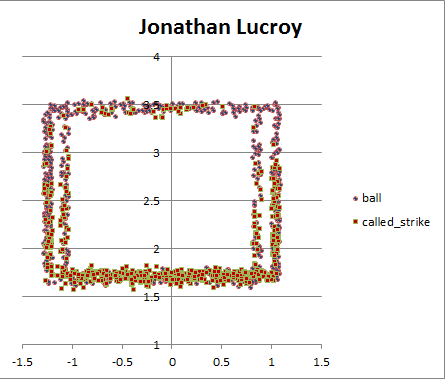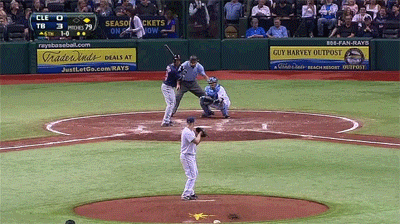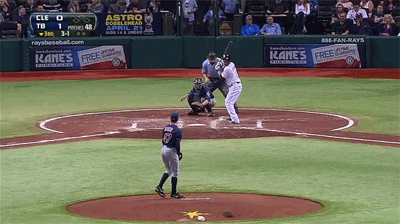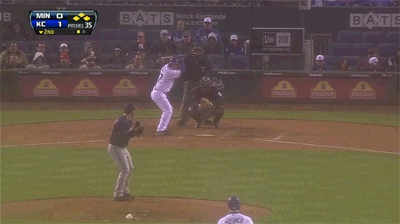Each week, before we get to the rankings of the best and worse frames and the GIFs that go with them, I want to talk briefly about some general-interest aspect of framing. In the first installment of this series, I mentioned, just as an aside, that “catchers differ in their ability to get calls in certain sections of the zone in a way that persists from year to year.” Let’s look into that a little more.
We classified pitches within two inches above the strike zone as “high,” within two inches below the strike zone as “low,” and within two inches to either side of the strike zone as “side.” Then we looked at how each catcher did at getting called strikes in each area from 2010-2013. Here are the baseline called strike rates for each section:
|
Area |
Called Strikes |
Called Pitches |
Called Strike Percentage |
|
High |
5200 |
27302 |
19.0 |
|
Low |
16666 |
50145 |
33.2 |
|
Side |
28725 |
123832 |
23.2 |
Let’s go one by one, starting with the “high” section.
High Pitches
The best at framing high pitches is Joe Mauer, with a 35.4 percent called strike rate. It’s tempting to chalk that up to his height; at 6’5”, Mauer is one of only two active catchers taller than 6’4”. If the umpire uses the position of the catcher’s glove as one of his frames of reference when calling strikes, it makes sense that a tall catcher would get more strike calls above the zone, since he wouldn’t have to make as pronounced a movement when reaching for the pitch. In support of that theory, here are the top five catchers in called high strike percentage, minimum 100 called high pitches:
|
Name |
Height |
Called High Strikes |
Called High Pitches |
Called High Strike Percentage |
|
Joe Mauer |
77 |
172 |
486 |
35.4 |
|
76 |
48 |
150 |
32.0 |
|
|
76 |
150 |
470 |
31.9 |
|
|
74 |
110 |
346 |
31.8 |
|
|
76 |
30 |
100 |
30.0 |
Molina is of above-average height, but he might just be on there because he’s Molina. The other guys are all among the tallest catchers in the game. Height is no guarantee of being among the best at framing high strikes, though: Matt Wieters, the other 6’5” catcher, was just barely above average in high strike rate, at 21.8 percent.
The correlation between catcher height and called high strike rate is a moderate .35, indicating that as catcher height increases, called high strike rate tends to as well. It’s not a given that a tall catcher will be good at getting high strikes, but it certainly seems to help.
Whether because of his height or for some other reason, Mauer is well below average at getting called strikes low, and only a bit above average on the sides of the zone:
High: 35.4% (86.3% above average)
Low: 19.5% (41.3% below average)
Sides: 26.3% (13.4% above average )
On the whole, Mauer is a good framer, but his framing skills aren’t well-distributed throughout the zone. As the Twins ration his appearances behind the plate in the years ahead, it might make sense for them to have him catch primarily pitchers who work up in the zone (Kevin Correia, Vance Worley) and try to skew his starts at first base or DH toward the days when someone who works low in the zone is starting (P.J. Walters, Scott Diamond). Incidentally, Francisco Liriano is one of the lowest throwers among starters, so throwing to Mauer may have made his control look even worse than it was.
Low Pitches
The king of framing low pitches is Jonathan Lucroy:
|
Name |
Height |
Called Low Strikes |
Called Low Pitches |
Called Low Strike Percentage |
|
Jonathan Lucroy |
72 |
689 |
1172 |
58.8 |
|
74 |
236 |
416 |
56.7 |
|
|
74 |
100 |
177 |
56.5 |
|
|
Erik Kratz |
76 |
87 |
158 |
55.1 |
|
75 |
703 |
1277 |
55.1 |
Lucroy isn’t tall, by baseball player standards, but the other guys on this list are—Kratz shows up again—so the link between height and low called strike rate seems a little less clear. This correlation is a weak -0.12, which suggests that shorter catcher are better at getting low strikes (or taller catchers are worse), but not by much. Why do tall catchers have a greater advantage at getting high strikes than short catchers do at getting low strikes? Maybe because it’s easier to bring the glove down than it is to bring the glove up. Keep that in mind for the next few sentences.
Like Mauer, Lucroy excels at framing in one area much more than the others, though he’s good enough everywhere to make him excellent overall.
High: 14.0% (26.3% below average)
Low: 77.1% (66.1% above average)
Sides: 25.7% (10.8% above average)
I linked to this video last week, but now that we have these numbers, I want to draw your attention to it again:
Here’s the relevant quote:
I give a real low target, so I’m really down here. For me, it’s a lot easier to come up to a ball and make it look like a strike than it is if you have a high target and come down. When you have a high target and you come down, the ball’s going to take you down and the umpire’s going to ball it because that’s what he sees. However, if you start low and come up to it, then you can keep it more in the strike zone, you can control it better. So I always try to bring balls up, a lot. You can get easy strikes like that.
First observation: “The umpire’s going to ball it” is just the best expression. I’m stealing it.
Second observation: It’s always nice when the numbers back up what a player says so perfectly. Lucroy’s comments suggest that it’s not so much player height that controls called strike rates for high and low pitches as it is height of the target, but player height is probably correlated pretty strongly with glove height. So far, I’ve been unable to obtain the COMMANDf/x data from Sportvision that would enable us to determine the exact relationship between where the glove starts out and framing skill in each area.
Pitches on the Sides
And finally, the top five guys who get calls on the corners:
|
Name |
Height |
Called Side Strikes |
Called Side Pitches |
Called Side Strike Percentage |
|
73 |
40 |
100 |
40.0 |
|
|
76 |
121 |
390 |
31.0 |
|
|
69 |
190 |
634 |
30.0 |
|
|
74 |
35 |
117 |
29.9 |
|
|
71 |
31 |
104 |
29.8 |
As we’d expect, the correlation between catcher height and called side strike rate is .008—in other words, there isn’t one.
Molina shows up on only one of the top five lists, but he’s seventh on the “sides” list and 19th on the low list. He’s not the best in any one area, but he’s among the best in every area:
High: 31.8% (67.4% above average)
Low: 42.0% (26.5% above average)
Sides: 29.1% (25.4% above average )
The anti-Molina is Ryan Doumit, who’s bad at everything and makes umpires ball it more than anyone else:
High: 13.3% (30% percent below average)
Low 15.6% (53.0% below average)
Sides: 16.5% (22.5% below average)
Some of you are visual people, so you might find this helpful. These are plots of balls and called strikes in the high, low, and side zones. I had to make them sort of small so they could fit side by side, but you can click on each one to enlarge. (Note: You don’t see a clean cutoff across the top and bottom of the plotted points because the top and bottom of the strike zone shifts based on the height of the batter. Another note: the sides of the strike zones have two “edges” because the horizontal boundaries vary by batter handedness.)
Mauer and Lucroy are on the top row, and it’s easy to see how different their distribution of called strikes is. Molina and Doumit are on the bottom row, and it’s easy to see how many more strikes Molina gets.
Here, have comparison GIFs:


On to the recap of the past week in framing.
This Week in Molina
Last week, I said that each edition of this series would cover the previous seven days, from Friday to Thursday. As it turns out, though, our PITCHf/x data is delivered and processed in the mornings, so there’s no time to include Thursday night’s PITCHf/x data in Friday morning’s article. For that reason, each Friday piece will instead cover the seven days from the previous Thursday through the Wednesday two days before its publication (in this case, April 4th through 10th).
Here’s a larger, more detailed image of called pitch outcomes with Molina catching (click to expand). Look at it. Learn it. Love it.
It was a solid week of framing for Molina. He played in five games, starting four and coming in as a defensive replacement in the ninth inning with the Rays up by two runs in the fourth. All told, he added four net strikes, with 18 pitches in the zone called balls and 22 pitches outside of the zone called strikes.
Weekly Net Strikes: 4
Weekly Net Runs: .52
Weekly Playing Time: 5 G, 4 GS, 36 innings
Yearly Playing Time: 7 G, 5 GS, 45 innings
Yearly Net Strikes: 3 (Changed slightly since last week, since we improved our methodology)
Yearly Net Runs: 0.39
Here are Molina’s best three frames of the week (not counting a couple on Chris Davis, which I showed last week, when I was including Thursday’s games in the Friday article). A few programming notes: last time, we ranked frames by distance from the center of the plate; this time, and in future editions, we’ll rank frames by distance from the closest point in the strike zone. (This way makes more sense, since it accounts for the height and strike zone boundaries of the batter. Using distance from the center of the zone, a low pitch to a short batter rates the same as a low pitch to a tall batter, but getting a strike on the latter is harder to do.) We’re not calculating strike probability per pitch yet, so there’s no adjustment for the count or the umpire, but we are correcting for PITCHf/x park calibration.
3. Date: April 6
Batter: Michael Brantley
Pitcher: Alex Cobb
Count: 1-0
Pitch type: 89-mph four-seam fastball
Distance from Strike Zone: .217 feet

2. Date: April 8
Batter: Craig Gentry
Pitcher: Jeremy Hellickson
Count: 1-1
Pitch type: 89-mph four-seam fastball
Distance from Strike Zone: .263 feet

1. Date: April 6
Batter: Jason Kipnis
Pitcher: Cesar Ramos
Count: 0-0
Pitch type: 90-mph sinker
Distance from Strike Zone: .307 feet

Molina set up inside, and the pitch drifted over the middle, so it wasn’t the cleanest reception—probably less smooth than the top two GIFs. He still got the strike. Last week I talked about how enjoyable the reactions generally are when batters get framed by Molina more than once in a plate appearance. Here’s Gentry taking an inside strike immediately after the low strike called on him above:

Best Frames of the Week
5. Date: April 10
Catcher: Ryan Doumit
Batter: Billy Butler
Pitcher: Liam Hendriks
Count: 0-1
Pitch type: 91-mph two-seam fastball
Distance from Strike Zone: .464 feet

One of the best frames of the week belongs to Ryan Doumit, who still managed to seem surprised that he'd caught the ball. Even a blind backstop finds a frame once in a while. In Doumit's defense, the Royals and Twins were apparently playing in London, circa 1952.
Thus far, Doumit has caught two games and DHed in seven. That seems like the right ratio, if you have to have him catch.
4. Date: April 6
Catcher: Lou Marson
Batter: Desmond Jennings
Pitcher: Trevor Bauer
Count: 3-1
Pitch type: 93-mph four-seam fastball
Distance from Strike Zone: .489 feet

Marson has historically been an awful framer himself, so this is sort of strange. Small sample size applies to framing, too (although framing performance tends to stabilize pretty quickly). Unless all the bad framers went to remedial framing camp over the winter.
3. Date: April 5
Catcher: Russell Martin
Batter: Andre Ethier
Pitcher: Jonathan Sanchez
Count: 2-1
Pitch type: 90-mph four-seam fastball
Distance from Strike Zone: .519 feet

If there's any catcher who can get Jonathan Sanchez to throw strikes, it would be Russell Martin. Unfortunately, there is no catcher who can get Jonathan Sanchez to throw strikes.
2. Date: April 10
Catcher: Geovany Soto
Batter: Sean Rodriguez
Pitcher: Derek Holland
Count: 1-0
Pitch type: 83-mph change-up
Distance from Strike Zone: .524 feet

Soto stayed almost perfectly still, except for his glove, which moved as little as possible.
1. Date: April 10
Catcher: Alex Avila
Batter: J.P. Arencibia
Pitcher: Rick Porcello
Count: 1-0
Pitch type: 88-mph two-seam fastball
Distance from Strike Zone: .635 feet

Sometimes I get tips on Twitter about notable news in framing. Here’s one from the night of that Avila frame:
@ben_lindbergh Tigers' radio guys are talking about Alex Avila's framing numbers.
— Eddie Bajek (@ebajek85) April 10, 2013
That called strike must have either prompted that discussion or made the announcers look smart. Unlike Arencibia, Avila is quiet behind the plate, with no noticeable head dip, but he caught that pitch casually, almost as if he didn’t expect a strike. Judging by Arencibia’s double-take, he didn’t expect a strike either.
Worst Frames of the Week
5. Date: April 10
Catcher: Ryan Doumit
Batter: Chris Getz
Pitcher: Liam Hendriks
Count: 0-0
Pitch type: 90-mph two-seam fastball
Distance from Strike Zone: .000 feet (1.115 feet from center)

Doumit is on the worst frames list, too. That's more like it, although this pitch didn't look all that much like a strike. Then again, Doumit isn't very good at making pitches look like strikes. That's the problem with Doumit.
4. Date: April 10
Catcher: Jarrod Saltalamacchia
Batter: Maicer Izturis
Pitcher: Jon Lester
Count: 0-0
Pitch type: 95-mph four-seam fastball
Distance from Strike Zone: .000 feet (0.964 feet from center)

I received one more relevant Twitter tip:
@ben_lindbergh Mitch Williams just blamed Salty's poor pitch framing as a partial cause of Hanrahan's blown save.
— Steve Andriola (@Rocco718) April 11, 2013
None of Saltalamacchia’s frames for Hanrahan on April 10 showed up as particularly poor, but he did have three of the 22 worst frames for the week. Lester missed his spot, but flipping the glove isn't a great way to disguise that.
3. Date: April 5
Catcher: Chris Iannetta
Batter: A.J. Pierzynski
Pitcher: Scott Downs
Count: 0-0
Pitch type: 86-mph sinker
Distance from Strike Zone: .000 feet (0.842 feet from center)

This doesn't seem like terrible technique. If anything, Iannetta seems to move the glove up, slightly but unnecessarily, before the ball reaches him.
2. Date: April 5
Catcher: Salvador Perez
Batter: Jimmy Rollins
Pitcher: Tim Collins
Count: 0-1
Pitch type: 75-mph curveball
Distance from Strike Zone: .000 feet (1.238 feet from center)

This one didn’t look like a strike when it got into the glove, but it definitely crossed the plate on the way there.
1. Date: April 7
Catcher: Taylor Teagarden
Batter: Wilkin Ramirez
Pitcher: Jason Hammel
Count: 0-0
Pitch type: 82-mph slider
Distance from Strike Zone: .000 feet (1.141 feet from center)

It may be the worst, but it's not the worst. But if you ignore the glove, it looks like it might've caught the inside part of the plate.
Thanks again to Ryan Lind for his research assistance, without which this article would have been way worse.
Thank you for reading
This is a free article. If you enjoyed it, consider subscribing to Baseball Prospectus. Subscriptions support ongoing public baseball research and analysis in an increasingly proprietary environment.
Subscribe now




1. Ben, as a former collegiate/amateur catcher I love this series. This is great stuff.
2. Re: Salty/Lester: that is on Lester. A more fair way to measure the most egregious anti-frames might be to measure the distance from the target (i.e. the corner of the zone where the catcher was setting up), although I doubt you have that data. But when a pitch takes you hard to your backhand (and outside your body frame) you have to turn the glove or you're going to be swatting it away. This is especially true on right pitches with arm-side run or lefty pitches that cut or slide.
3. Re: Perez: one thing that's very hard to see on TV is that a good catcher will catch a pitch that is both slow and low (i.e. slow curve) out in front of himself a little more so he can stick it before it falls below the zone. Perez obviously didn't do that here and it cost him a strike. That's another advantage to LuCroy's low target approach. It's easier to extend out and up and get a call than extend out and down and get one. This is less important when a pitcher is throwing 98 and on a line than 65.
4. Re: Doumit: he seems like he's making an effort to keep his head a little more still this year.
That would certainly be a problem with COMMANDf/x, not that we know anything about how that data is being used...